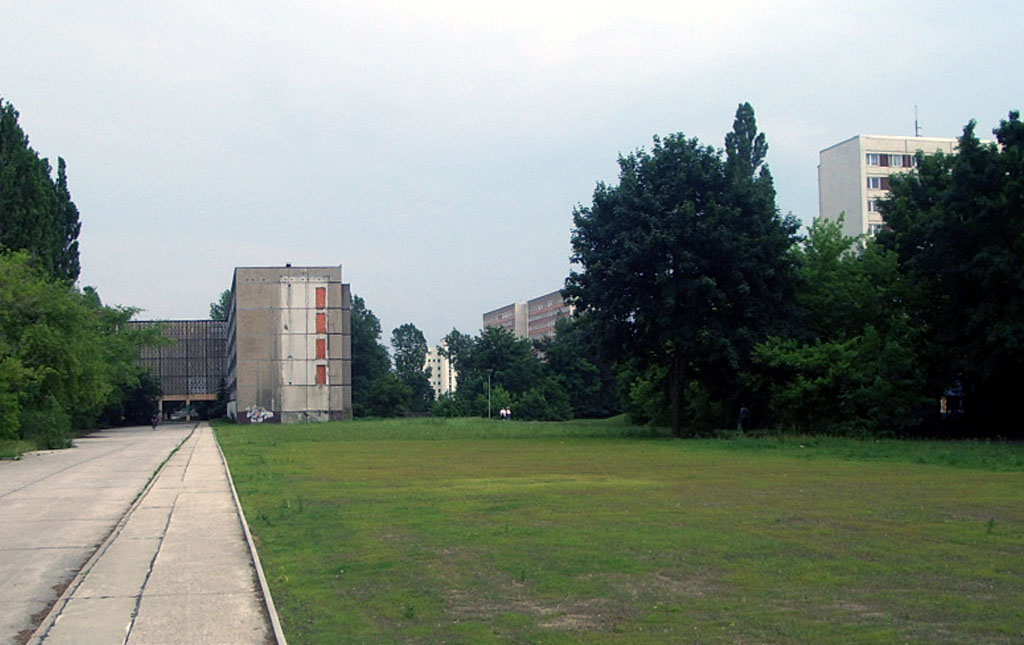30-06-05 // MODEL CITY – INTERVIEW WITH MAGRITTA FASSL

Hoyerswerda-Neustadt in decay, photo by Bernd Upmeyer, 2005
Bernd Upmeyer spoke on behalf of MONU with with Margitta Fassl, the managing director of the ‘Wohnungsgesellschaft Hoyerswerda’. The reunification of Germany and the transformation of the former GDR from a socialist plan-economy into a market economy almost over night radically changed the economic and political realities of all cities and villages in what is now called the new states of Germany. While some select cities have adapted relatively well to the new structures, others seem to have drifted into a downward spiral of job-loss and population decline. This is particularly obvious in cities that had been chosen as model cities by the GDR regime and had been especially promoted, that are now, after the collapse of socialism, existing in the shadows and suffering dramatic population losses, unemployment, political disorientation and a lack of economic perspectives. Today they are model-cities of decline.
Hoyerswerda is one of these cities. Hoyerswerda developed in only 25 years from a small town with 7,000 inhabitants to a socialist model city with 70,000 people. It was planned to accommodate 100,000 at some point. Hoyerswerda was built up into the largest brown-coal refineries of Europe. For the thousands of new employees, housing was created in the periphery of Hoyerswerda. In the new part, Hoyerswerda-Neustadt, a total of ten new housing complexes with several thousand units and a new city center were created until the 80’s in what was the first use of industrial large prefab housing construction. After the fall of the iron curtain and the reunification, the brown-coal industry collapsed. The ensuing economic demise caused the city to lose almost half of its population. Every year about 1,800 people leave the city – five every day.
In spite of all the privatization efforts Hoyerswerda-Neustadt, the new part of Hoyerswerda has a very peculiar ownership structure. There are basically only two property owners for the whole housing stock: a housing coop and the Wohnungsgesellschaft [housing management company] Hoyerswerda. Today about 40% of the all apartments belong to the Wohnungsgesellschaft Hoyerswerda. One could say that the transformation of the company, its buildings and tenant population is representative for the transformation of the city.
Bernd Upmeyer: The ‚Wohnungsgesellschaft Hoyerswerda’ was founded in 1991. You are the managing director since 1993. What was the situation on your first day of work?
Margitta Fassl: At that time the first thing to do was to adjust the rents from the GDR-level to one that actually takes into account the cost of maintenance and renovation. These adjustments dragged out until 1996. Naturally the economic situation was very difficult because of that. On top of that we had the fact that the properties were not yet completely allocated to the Wohnungsgesellschaft. The property, which used to belong to the city, had to be re-allocated, so that you had mortgage-able real estate, which you need to go to a bank and get a loan. Those were the main tasks at hand. We also had an obligation to privatize, which proved to be difficult to realize since we mostly had multi-family homes with 18 units or more, and to transfer those into private property was a venture in uncharted territory. This process depends to a large degree on the economic circumstance of the individual and not everybody is interested in buying private property. You also had the first signs of high unemployment, which made people even more careful. There also was a tendency to fulfill other housing ideals – in the early 90’s we saw a strong increase in the development of single family homes in the periphery, which happened at the expense of our housing units.
BU: Your organization mainly owns ‘Plattenbauten’?
MF: Yes. Today we own about 11,000 apartments thereof are 9.000 so-called ‚Plattenbauten’ in the new part of Hoyerswerda and about 2,000 in the old city.
BU: You mentioned that a large part of those apartments belonged to the city – were publicly owned by the GDR so to say.
MF: In 1990 the federal municipalization law was passed stipulating that municipalities would from that point on own the housing units that were within their jurisdiction. Before, our housing management company was called the VEB Gebaeudewirtschaft Hoyerswerda, which also owned units outside of the municipality. However those were then all of a sudden no longer belonged to us since they were not within the jurisdiction of Hoyerswerda. On the other hand the city of Hoyerswerda brought other housing units, which were within its jurisdiction into the Wohnungsgesellschaft…
…the complete interview was published in MONU #3 on the topic of Political Urbanism on July 5, 2005.
Title: Model City
Project: Interview with Margitta Fassl
Date: June 2005
Type: Commissioned interview
Topic: Political Urbanism
Organizer: MONU
Status: Published
Publications: MONU #3, P.32-37
Interviewer: Bernd Upmeyer